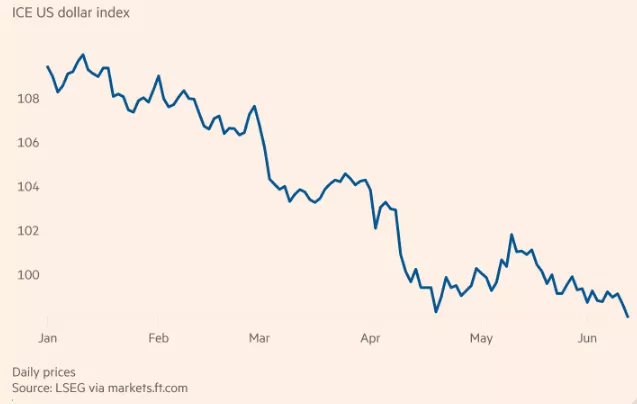The Falling U.S. Dollar Signals The Decline In American Exceptionalism

Image Source: Pixabay
Once again, currency traders respond to the latest chaotic policy decision by Trump, this time pushing the USD to a three-year low. Almost daily, participants in the financial markets are hit with an on-again-off- again set of tariff decisions, that has equity markets moving from pillar-to-post and long-term interest rates remaining elevated. In his latest pronouncement, Trump said he will send a letter to all US major trading partners outlining new tariffs rates in the next few weeks, as the 90-day pause on reciprocal tariffs is fast approaching its end. While the small daily movements in the USD can be accounted for by erratic decisions regarding tariffs, the overall steady decline in the value of the USD is unmistakably signalling a major shift in the Holy Grail of currencies. This decline did not just start with Trump’s election, rather there has been a universal move away from the USD in a rather orderly fashion. Trump just accelerated the USD decline. A strong dollar was always the hallmark of US trade and foreign investment policy, until Trump took office this year. The USD has declined by 10% since January.

Asian countries are shedding USD holdings in record amounts, largely in response to the rather chaotic policies that Trump champions, starting with the trade war, but moving into a longer-term perspective. Japan and China are the two largest holders of US government debt. Both countries have a significant amount of US sovereign debt plus cash deposits. As of May 2025, China’s foreign exchange reserves totalled $3.3 T, of which nearly half resides in US debt, and Japan holds $1.3 T in USD assets.China, in particular, has been shedding its US treasury holdings in a rather slow, but orderly fashion. Japan is doing the same, but in relatively smaller amounts. Nonetheless, both countries have adopted a broad policy of gradual divestment, away from the USD, in an effort to avoid being overly exposed to the vicissitudes of US fiscal and monetary policy developments. Simply put, the US is no longer considered a safe haven it once enjoyed.
The US and China have long been bucking heads regarding trade imbalances, state subsidies, and technology transfer. These bilateral issues have prompted Trump to introduce excessive tariffs, and China in response to introducing tariffs of equal amount on US imports. The tensions are out in the open, and this is playing directly into the hands of those who fear a further decline in the USD.
The EU nations hold a vast array of USD assets, amounting to several trillion-dollar positions in Treasuries, corporate debt and equities. The US dollar now constitutes more than 50% of all foreign reserves held in the European Central Bank. The recent decline in the USD index only puts additional pressure on the EU to reduce its reliance on the USD.
The USD remains the world’s primary reserve currency, but its status is diminishing under Trump’s administration.The economic instability of US trade and foreign investment policy has forced, once close business partners, to seek alternative markets, especially as the US seems to be moving towards “fortress America”. But make no mistake, the decisions by such economic powerhouses, as China and Japan, to reduce their exposure to the USD will continue to re-shape the currencies reserve status. Strangely enough, the USD remains passive as Asian and European investors weigh the merits of holding dollars.
More By This Author:
U.S. Tariff Hits The Canadian Economy As The Trade Deficit Soars
Does The Trump Administration Want A Strong Or Weak Dollar?
Trump’s Great Walk Back On Tariffs



